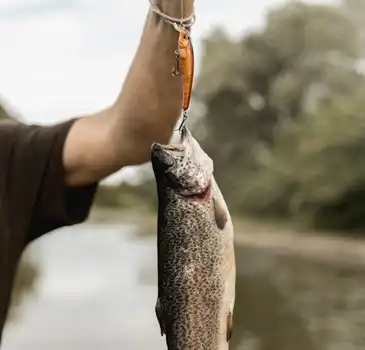Annual: the licence year, beginning April 1 and ending on March 31.
Barbless Hook: a hook without a barb on
any part of the hook, including both the point and shank. Existing tackle may be modified by completely removing the barb or by crimping the barb down so that its point is flush against the shaft.
Daily Quota: the maximum number of fish of a given species, group of species, or size class that you may keep in one calendar day.
Fly Fishing: angling with a line to which only an artificial fly is attached (floats, sinkers, or attracting devices may not be attached to the line when fishing is restricted to "fly fishing only").
Hatchery Trout: in some waters, hatchery trout may be harvested, but wild trout must be released. In these waters, hatchery trout are marked before stocking by removal of their adipose fin. Therefore, these hatchery trout must have a healed scar in place of the missing fin.
Licence Year: the period beginning April 1 and ending March 31.
Management Unit: a Management Unit is a subdivision of a region. For detailed maps of Management Units, the British Columbia Recreational Atlas is available at many bookstores.
Non-Resident: means you are not a "resident", but (a) you are a Canadian citizen or landed immigrant, OR (b) your primary residence is in Canada, AND you have resided in Canada for the immediately preceding 12 months.
Non-Resident Alien: means you are neither a "resident" nor a "non-resident".
Ordinary Residence: a residential dwelling where a person normally lives, with all associated connotations including a permanent mailing address, telephone number, furnishings and storage of automobile; the address on one's driver's licence and automobile registration, where one is registered to vote. A motor home or vessel at a campsite or marina is not considered to be an ordinary residence.
Possession Quota: the number of fish of any species that an angler may have in their possession at any given time, EXCEPT at place of ordinary residence (see above). In most instances, the possession quota is two times the daily quota. See Tables for exceptions.
Set Line: a fishing line that is left unattended in the water.
Single Hook: a hook having only one point. (In contrast, a treble hook is a hook having three points on a common shaft.) Note: Use of a treble hook is permitted unless "single hook" is specified.
Snagging (Foul Hooking): hooking a fish in any other part of its body other than the mouth. Attempting to snag fish of any species is prohibited. Any fish willfully or accidentally snagged must be released immediately.
Stream Mouth: the point at which the surface elevation of a stream and the water body into which it flows are the same, except as posted by signs or markers or otherwise defined.
Tributaries: all streams that contribute to a larger stream or to a lake.
